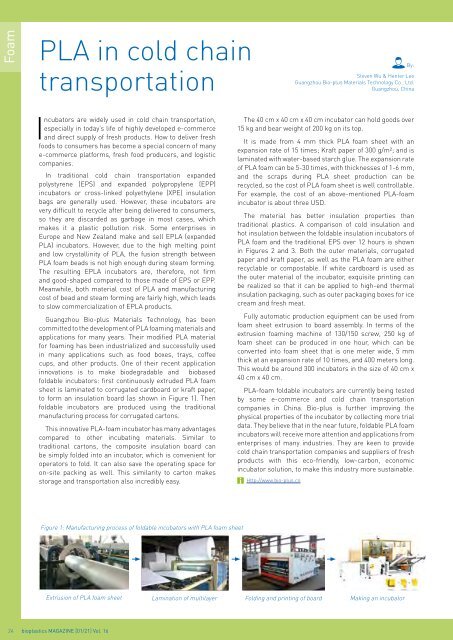Issue 01/2021
Highlights: Automotive Foam Basics: Enzymes
Highlights:
Automotive
Foam
Basics: Enzymes
Create successful ePaper yourself
Turn your PDF publications into a flip-book with our unique Google optimized e-Paper software.
Foam<br />
PLA in cold chain<br />
transportation<br />
By:<br />
Steven Wu & Henter Lee<br />
Guangzhou Bio-plus Materials Technology Co., Ltd.<br />
Guangzhou, China<br />
Incubators are widely used in cold chain transportation,<br />
especially in today’s life of highly developed e-commerce<br />
and direct supply of fresh products. How to deliver fresh<br />
foods to consumers has become a special concern of many<br />
e-commerce platforms, fresh food producers, and logistic<br />
companies.<br />
In traditional cold chain transportation expanded<br />
polystyrene (EPS) and expanded polypropylene (EPP)<br />
incubators or cross-linked polyethylene (XPE) insulation<br />
bags are generally used. However, these incubators are<br />
very difficult to recycle after being delivered to consumers,<br />
so they are discarded as garbage in most cases, which<br />
makes it a plastic pollution risk. Some enterprises in<br />
Europe and New Zealand make and sell EPLA (expanded<br />
PLA) incubators. However, due to the high melting point<br />
and low crystallinity of PLA, the fusion strength between<br />
PLA foam beads is not high enough during steam forming.<br />
The resulting EPLA incubators are, therefore, not firm<br />
and good-shaped compared to those made of EPS or EPP.<br />
Meanwhile, both material cost of PLA and manufacturing<br />
cost of bead and steam forming are fairly high, which leads<br />
to slow commercialization of EPLA products.<br />
Guangzhou Bio-plus Materials Technology, has been<br />
committed to the development of PLA foaming materials and<br />
applications for many years. Their modified PLA material<br />
for foaming has been industrialized and successfully used<br />
in many applications such as food boxes, trays, coffee<br />
cups, and other products. One of their recent application<br />
innovations is to make biodegradable and biobased<br />
foldable incubators: first continuously extruded PLA foam<br />
sheet is laminated to corrugated cardboard or kraft paper,<br />
to form an insulation board (as shown in Figure 1). Then<br />
foldable incubators are produced using the traditional<br />
manufacturing process for corrugated cartons.<br />
This innovative PLA-foam incubator has many advantages<br />
compared to other incubating materials. Similar to<br />
traditional cartons, the composite insulation board can<br />
be simply folded into an incubator, which is convenient for<br />
operators to fold. It can also save the operating space for<br />
on-site packing as well. This similarity to carton makes<br />
storage and transportation also incredibly easy.<br />
The 40 cm x 40 cm x 40 cm incubator can hold goods over<br />
15 kg and bear weight of 200 kg on its top.<br />
It is made from 4 mm thick PLA foam sheet with an<br />
expansion rate of 15 times; Kraft paper of 300 g/m²; and is<br />
laminated with water-based starch glue. The expansion rate<br />
of PLA foam can be 5-30 times, with thicknesses of 1-6 mm,<br />
and the scraps during PLA sheet production can be<br />
recycled, so the cost of PLA foam sheet is well controllable.<br />
For example, the cost of an above-mentioned PLA-foam<br />
incubator is about three USD.<br />
The material has better insulation properties than<br />
traditional plastics. A comparison of cold insulation and<br />
hot insulation between the foldable insulation incubators of<br />
PLA foam and the traditional EPS over 12 hours is shown<br />
in Figures 2 and 3. Both the outer materials, corrugated<br />
paper and kraft paper, as well as the PLA foam are either<br />
recyclable or compostable. If white cardboard is used as<br />
the outer material of the incubator, exquisite printing can<br />
be realized so that it can be applied to high-end thermal<br />
insulation packaging, such as outer packaging boxes for ice<br />
cream and fresh meat.<br />
Fully automatic production equipment can be used from<br />
foam sheet extrusion to board assembly. In terms of the<br />
extrusion foaming machine of 130/150 screw, 250 kg of<br />
foam sheet can be produced in one hour, which can be<br />
converted into foam sheet that is one meter wide, 5 mm<br />
thick at an expansion rate of 10 times, and 400 meters long.<br />
This would be around 300 incubators in the size of 40 cm x<br />
40 cm x 40 cm.<br />
PLA-foam foldable incubators are currently being tested<br />
by some e-commerce and cold chain transportation<br />
companies in China. Bio-plus is further improving the<br />
physical properties of the incubator by collecting more trial<br />
data. They believe that in the near future, foldable PLA foam<br />
incubators will receive more attention and applications from<br />
enterprises of many industries. They are keen to provide<br />
cold chain transportation companies and suppliers of fresh<br />
products with this eco-friendly, low-carbon, economic<br />
incubator solution, to make this industry more sustainable.<br />
Http://www.bio-plus.cn<br />
Figure 1: Manufacturing process of foldable incubators with PLA foam sheet<br />
Extrusion of PLA foam sheet Lamination of multilayer Folding and printing of board Making an incubator<br />
24 bioplastics MAGAZINE [<strong>01</strong>/21] Vol. 16


















